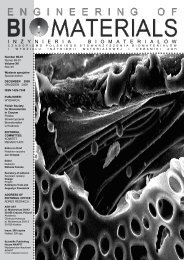62 - Polskie Stowarzyszenie BiomateriaÅów
62 - Polskie Stowarzyszenie BiomateriaÅów
62 - Polskie Stowarzyszenie BiomateriaÅów
You also want an ePaper? Increase the reach of your titles
YUMPU automatically turns print PDFs into web optimized ePapers that Google loves.
Preparation of PBT/DLA/PEG 1000 terpolymer with nano–<br />
HAP I and without thermal stabilizer shows unexpected<br />
result of improving mechanical properties not only due to the<br />
reinforcing effect of nanoparticles (what is rather common<br />
feature of nanocomposites) but also imparting good thermal<br />
stability during the processing stage.<br />
We noticed that combining VE with HAP I rather decreases<br />
tensile strength of prepared material and enhances<br />
elongation at break as compared to PBT/DLA/PEG 1000 /HAP I<br />
without VE.<br />
Due to different chemical composition of HAP III as<br />
compared to HAP I (sintered vs. non-calcined), resulted<br />
properties of nanocomposites are signifi cantly different as<br />
compared to systems containing HAP I. Tensile strength<br />
curves for the material with HAP III and VE (FIG.4b.) showed<br />
that small addition of nanofiller along with thermal stabilizer,<br />
strongly improves polymer strength and elongation at break<br />
by 1100 % indicating the nanoreinforcement effect and synergistic<br />
effect of VE and HAP III on mechanical properties.<br />
This positive effect can also be a consequence of good<br />
adhesion of nanofi ller to polymer matrix as presented in<br />
SEM pictures in FIG.3f.<br />
Conclusions<br />
An infl uence of HAP nanoparticles incorporated into<br />
elastomeric multiblock PBT/DLA/PEG 1000 terpolymer matrix<br />
by in situ polycondensation reaction on the chemical structure,<br />
morphology, thermal and mechanical properties was<br />
investigated. We demonstrated that in situ polycondensation<br />
reaction from the melt can be considered as a very<br />
effective method to produce nanocomposites of uniformly<br />
dispersed nanoparticles within polymer matrix. Addition of<br />
nanoparticles increased glass transition temperature of hybrid<br />
systems as compared to the neat materials, showing T g<br />
in a range from – 58°C to – <strong>62</strong>°C, while melting point, T m2 ,<br />
was slightly increased (increase from 176°C to 178°C as<br />
compared to 172.6°C for PBT/DLA/PEG 1000 containing VE).<br />
Addition of HAP I reduced elongation and tensile strength<br />
as compared to non-modifi ed PBT/DLA/PEG 1000 material.<br />
The best mechanical properties were observed for material<br />
containing sintered HAP III and VE.<br />
Acknowledgement<br />
This work has been fi nanced from the research project<br />
3 T08E 036 28<br />
7<br />
References<br />
[1] Fakirov S.: Handbook of Condensation Thermoplastic Elastomers.<br />
New York: WILEY- VCH, Verlag GmbH & C 2005.<br />
[2] Reis R.L., Julio S.R.: Biodegradable systems in tissue engineering<br />
and regenerative medicine. New York: CRC Press 2005.<br />
[3] Azevedo M.C., Reis R.L., Claase M.B., Grijpma D.W., Feijen J.:<br />
Development and properties of polycaprolactone/hydroxyapatite<br />
composite biomaterials. J Mater Sci Mater Med 2003; 14: 103-<br />
107.<br />
[4] Tripathy A.R., Burgaz E., Kukureka S.N., MacKnight W.J.:<br />
Poly(butylene terephthalate) nanocomposites prepared by in-situ<br />
polymerization. Macromolecules 2003; 36: 8593-8596.<br />
[5] El Fray M.: Nanostructured elastomeric biomaterials for soft<br />
tissue reconstruction. Warsaw Publishing House of the Warsaw<br />
University of Technology, Warsaw 2003.<br />
[6] El Fray M., Boccaccini A.R.: Novel hybrid PET/DFA–TiO 2<br />
nonocomposites by in situ polycondensation. Mater Lett 2005;<br />
2300–2304<br />
[7] Holden G., Legge N.G., Quirk R., Schroeder H.E. Eds. Thermoplastic<br />
Elastomers. New York: Hanser Publishers, 1996.<br />
[8] El Fray M.: Novel polyester elastomeric biomaterials. Engineering<br />
of Biomaterials 2004; 34: 14–15.<br />
[9] El Fray M.: Synthesis and thermal properties of poly(ester<br />
– siloxane) multiblock copolymers. Design Monom Polym<br />
2000;3(3):325–337.<br />
[10] El Fray M.: Synthesis and structure of elastomeric poly(ester–<br />
block–ether)s. Macromol Symp 1997; 122: 335–342.<br />
[11] El Fray M., Słonecki J.: Dimer fatty acid–modifi ed poly(ester–<br />
β–ether)s: synthesis and properties. Polym Plast Technol Eng<br />
1999; 38(1): 51–69.<br />
[12] Deschamps A.A., Grijpma D.W., Feijen J.: Poly(ethylene<br />
oxide)/poly(butylene terephthalate) segmented block copolymers:<br />
the effect of copolymer composition on physical properties and<br />
degradation behavior. Polymer 2001; 42: 9335–9345.<br />
[13] Zdebiak P., El Fray M.: New amphiphilic copolymers. Synthesis<br />
and properties, Przemysl Chemiczny 2006; (85/8-9): 986–989.<br />
[14] Ślosarczyk A., Stobierska E., Paszkiewicz Z., Gawlicki M.:<br />
Calcium phosphate materials prepared from precipitates with various<br />
calcium : phosphate molar ratios. J. Am. Ceram. Soc. 1996;<br />
79,10: 2539-44













